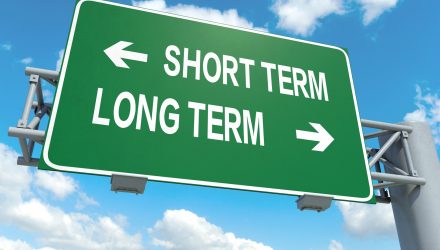Just like a game of golf, different clubs have different roles when it comes to playing the long game versus the short game. Right now, in today’s fixed income environment, it could benefit investors if they played the short game with short duration fixed income exchange-traded funds (ETFs).
During times of heavy volatility like that experienced during May, short-term bonds were the apple of fixed-income investors’ eyes as they longed for shorter duration debt during the market oscillations. Most investors were fleeing to the safe confines of all fixed income assets, but as the central bank is seemingly looking to either stand part or cut interest rates, short duration bonds could be the preference moving forward.
Furthermore, risks stemming from an inverted yield curve are abound as rates remain at bottom-barrel lows.
“Interest rates are so low, it’s tough to argue in favor of investing in longer duration bonds,” Simeon Hyman, Global Investment Strategist at ProShares noted. “The inverted yield curve means that the reward for taking duration risk comes with lower yield. One of the few ways for this bet to pay off would be if trade wars prompted a recession and yields fell even further. Keep in mind that the all-time low yield on the 10-year U.S. Treasury was just under 1.5%, so even in that scenario, the upside is likely limited.”
Investors could also give credence to corporate bonds in particular. With quality in mind, this means a calculated move towards investment-grade debt.
“The risk/reward tradeoff looks a bit more attractive in corporate bonds,” Hyman noted further. “After May’s sell-off, spreads on both investment-grade bonds and high-yield bonds now stand right around their 5-year average. Spreads on investment-grade bonds are even near their long-term average, which includes the extremely wide spreads experienced in the great recession. No doubt a significant recession would negatively impact corporate bonds, but at least they are priced for a fair return in a middle-ofthe-road scenario, which is more than can be said for U.S. Treasuries.”
Short Duration ETF Options
Investors can limit exposure to long-term debt with ETFs like the SPDR Portfolio Short Term Corp Bd ETF (NYSEArca: SPSB), which seeks to provide investment results that correspond to the performance of the Bloomberg Barclays U.S. 1-3 Year Corporate Bond Index. SPSB invests at least 80 percent of its total assets in securities designed to measure the performance of the short-termed U.S. corporate bond market. Ideally, shorter-term bond issues with maturities of three to four years are ideal to minimize duration exposure should the bull market enter another correction phase.
Another short-term bond ETF option is the iShares 1-3 Year Credit Bond ETF (NASDAQ: CSJ), which tracks the investment results of the Bloomberg Barclays U.S. 1-3 Year Credit Bond Index where 90 percent of its assets will be allocated towards a mix of investment-grade corporate debt and sovereign, supranational, local authority, and non-U.S. agency bonds that are U.S. dollar-denominated and have a remaining maturity of greater than one year and less than or equal to three years–this shorter duration is beneficial during recessionary environments or deeper corrections in the market.
For more market trends, visit ETFTrends.com

